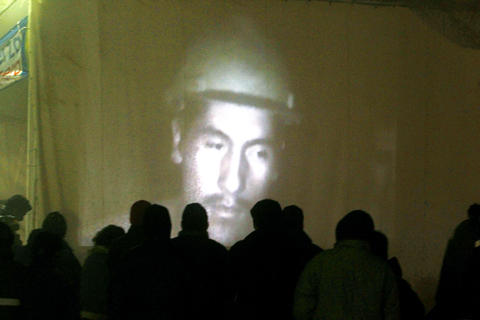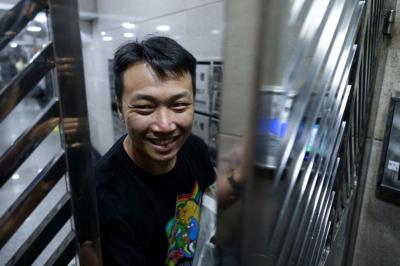An Australian-made hydraulic bore was being assembled yesterday for the months-long drilling of a shaft big enough to rescue 33 trapped miners, some of whom were showing signs of depression.
“We’ve finished building the machine’s platform ... we hope between Sunday and Monday to begin drilling the shaft,” the operation’s chief engineer, Andre Sougarret, told reporters.
The bore, an Australian-made Strata 950, drills at a maximum rate of 20m per day. The initial narrow shaft it will dig will have to be doubled in diameter to permit a man to pass through, he explained.

PHOTO: REUTERS
Once it is fully assembled and operational, engineers said it will take up to four months of painstaking drilling to reach the trapped miners, 700m down the gold and silver mine that collapsed on Aug. 5.
Most of the miners were in good spirits in a 45-minute video they sent to their families at the surface after their three-week ordeal, but a handful of them appeared to be struggling psychologically, officials said on Friday.
“Five of the miners are isolated, are not eating well and do not want to appear on camera,” Chilean Health Minister Jaime Manalich said. “This is what we call depression.”
The minister said a psychiatrist would attempt to treat the men over an intercom system dropped to them.
The mental malaise emerging among the miners holed up in a hot and cramped shelter they themselves have described as “hell” augured badly for the months of continued captivity the men have yet to endure.
During that time, the men will receive water, sustenance, medical care and communication through a tiny drill probe hole that located them last Sunday.
The video footage shot by the miners and broadcast in Chile late on Thursday showed most of the group were coping with their confinement.
“We’ve organized everything really well down here,” one of the miners, sporting a scraggly beard and pointing to a corner reserved for medical supplies, said in excerpts of the video.
“This is where we entertain ourselves, where we have a meeting every day, where we make plans. This is where we pray,” he said.
About a dozen other miners waved at the mini-camera, which was delivered via one of the metal capsules dropped to them regularly.
Chilean authorities have already taken steps to boost the men’s mental resilience for the ordeal that still lays ahead, notably by reaching out to organizations and individuals with experience in prolonged isolation.
Four officials from the US space agency NASA were due to arrive today or tomorrow in Chile to provide expertise, while submarine commanders in Chile’s navy have already given advice.
At least five people from a group of 16 who survived 72 days in the Andes after a 1972 airplane crash by cannibalizing dead passengers were also to head from Uruguay to the scene of the mine rescue drama next week.
“When they get out and they hug each other above ground, they’ll see how little two or three months is in a lifetime,” said one of the crash survivors, Jose Luis Inciarte, 62.
As rescue operations and psychological assistance ramped up, so did legal actions against the owners of the mine where the men are trapped.
San Esteban Mining, the company responsible for the gold and copper mine in northern Chile, was ordered on Thursday by a local judge to freeze US$1.8 million in revenue so that it can pay future compensation to 26 of the families of those trapped.
One family has also filed a lawsuit over the accident, accusing the mine company and government inspectors of criminal negligence by allowing the facility to reopen in 2008 after a worker accident led to its closure in 2007.
Chile’s mining minister announced late on Friday he will revise mine safety regulations and more than double the budget and staff monitoring the sector in the wake of the Aug. 5 accident.
“We can’t guarantee there will be no more accidents, but we can make company leaders more aware of the importance of worker safety,” Laurence Golborne told reporters.

Four people jailed in the landmark Hong Kong national security trial of "47 democrats" accused of conspiracy to commit subversion were freed today after more than four years behind bars, the second group to be released in a month. Among those freed was long-time political and LGBTQ activist Jimmy Sham (岑子杰), who also led one of Hong Kong’s largest pro-democracy groups, the Civil Human Rights Front, which disbanded in 2021. "Let me spend some time with my family," Sham said after arriving at his home in the Kowloon district of Jordan. "I don’t know how to plan ahead because, to me, it feels

Polish presidential candidates offered different visions of Poland and its relations with Ukraine in a televised debate ahead of next week’s run-off, which remains on a knife-edge. During a head-to-head debate lasting two hours, centrist Warsaw Mayor Rafal Trzaskowski, from Polish Prime Minister Donald Tusk’s governing pro-European coalition, faced the Eurosceptic historian Karol Nawrocki, backed by the right-wing populist Law and Justice party (PiS). The two candidates, who qualified for the second round after coming in the top two places in the first vote on Sunday last week, clashed over Poland’s relations with Ukraine, EU policy and the track records of their

‘A THREAT’: Guyanese President Irfan Ali called on Venezuela to follow international court rulings over the region, whose border Guyana says was ratified back in 1899 Misael Zapara said he would vote in Venezuela’s first elections yesterday for the territory of Essequibo, despite living more than 100km away from the oil-rich Guyana-administered region. Both countries lay claim to Essequibo, which makes up two-thirds of Guyana’s territory and is home to 125,000 of its 800,000 citizens. Guyana has administered the region for decades. The centuries-old dispute has intensified since ExxonMobil discovered massive offshore oil deposits a decade ago, giving Guyana the largest crude oil reserves per capita in the world. Venezuela would elect a governor, eight National Assembly deputies and regional councilors in a newly created constituency for the 160,000

North Korea has detained another official over last week’s failed launch of a warship, which damaged the naval destroyer, state media reported yesterday. Pyongyang announced “a serious accident” at Wednesday last week’s launch ceremony, which crushed sections of the bottom of the new destroyer. North Korean leader Kim Jong-un called the mishap a “criminal act caused by absolute carelessness.” Ri Hyong-son, vice department director of the Munitions Industry Department of the Party Central Committee, was summoned and detained on Sunday, the Korean Central News Agency (KCNA) reported. He was “greatly responsible for the occurrence of the serious accident,” it said. Ri is the fourth person